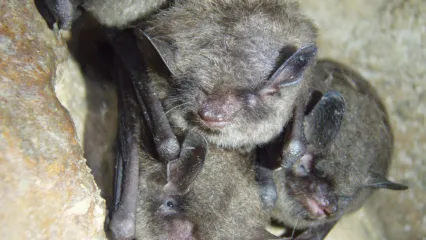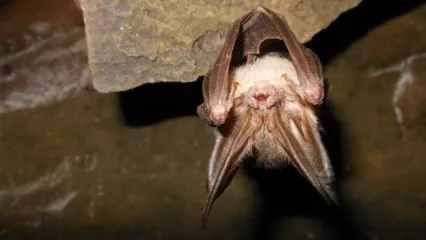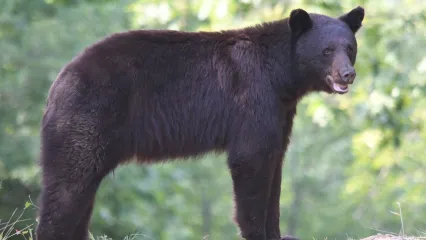
Description
This medium-sized bat is 4-5 inches long with a wingspan of approximately 9-10 inches. Similar in appearance to other Myotis bats, the Indiana bat can be distinguished by the dull lead color of the base of the dorsal hairs. The ear, wing and tail membrane is pinkish.
Size
Approximately 4-5 inches in length. Wingspan of 9-10 inches.
Habitat
The range of this species in Oklahoma extends throughout portions of the Ouachita Mountains, though a few records from the Ozark highlands also exist. Over 80 percent of the entire population hibernates in caves in Indiana, Missouri, and Kentucky. Since Oklahoma is on the southwestern edge of its range, only a few Indiana bats have ever been recorded in the state. Although the Indiana bat has not been observed in the Ozark highlands for many years, conservation efforts at caves in the area may encourage their future use as winter hibernacula. Only one cave in LeFlore County is known to be used regularly by Indiana bats as a winter hibernation site. Indiana bats use caves almost exclusively for winter hibernacula, but venture out into forests during the summer months.
Life Cycle
Similar to the northern long-eared bat, the Indiana bat uses both caves and trees as roosting sites. During summer, males and females use trees as roost sites and will not return to caves until fall. During fall, Indiana bats undergo a “swarming” behavior, where individuals may disperse for several miles and gather in large numbers to mate. Females undergo delayed reproductive development until spring, after which they will leave caves and seek trees for maternity sites to raise their young. Females give birth to one pup per year. Similar to the gray bat, Indiana bats are largely migratory and travel many miles to winter hibernation sites. Like other Myotis, this bat feeds on a variety of flying insects.
The Indiana bat is naturally rare and restricted in its Oklahoma range, and is susceptible to a variety of impacts. As with other cave-dependent bats, Indiana bats can be sensitive to disturbance during hibernation periods. Human visitation and vandalism of occupied caves is considered to be the primary factor in the decline of this species. White-nose syndrome, a disease that affects hibernating bats, has caused population declines in portions of the Indiana bat range. It remains unknown as to how the spread of white-nose syndrome will ultimately affect the overall recovery of this species. Cave-gating and monitoring efforts for other endangered bats in the Ozark highlands could benefit Indiana bats, especially through the long-term ESA Section 6 grant partnership between the Wildlife Diversity Program and Rogers State University. The only known Indiana bat winter hibernaculum in the state is owned by the U.S. Forest Service. The agency protects the cave from human entry and disturbance and informs the public of the cave’s sensitive species. Management activities that maintain and encourage native and diverse plant communities in mixed oak-hickory-pine forests can benefit species like the Indiana bat. Healthy forest management through prescribed fire, thinning, and invasive species control will provide both adequate summer roosting habitat and an abundant insect community.
How To Observe
For more information about this and other bats, download the free "Bats of Oklahoma Field Guide."


